Florence’s pizza scene has seen some interesting changes in recent years. The Florentine spoke with three award-winning (and down-to-earth) pizzaioli—Marco Manzi, Romualdo Rizzuti and Giovanni Santarpia—about quality pizza, their preferred techniques and favourite toppings.
Marco Manzi
POB: 27/09/1990, Naples
In addition to Giotto Pizzeria Bistrot (via Francesco Veracini 22/d) and recent addition along via Panzani, Marco Manzi also manages the Giotto On The Road food van with a wood-fired oven.
Romualdo Rizzuti
POB: Vallo della Lucania, Salerno
Romualdo Rizzuti’s pizzas can be tasted at Le Follie di Romualdo (via di S. Niccolò 39R) and, in the summer, at the Al Fresco trattoria at Four Seasons Florence.
Giovanni Santarpia
POB: Castellammare di Stabia
Savour Giovanni Santarpia’s pizzas at his namesake restaurant in via Senese 155r, Florence.
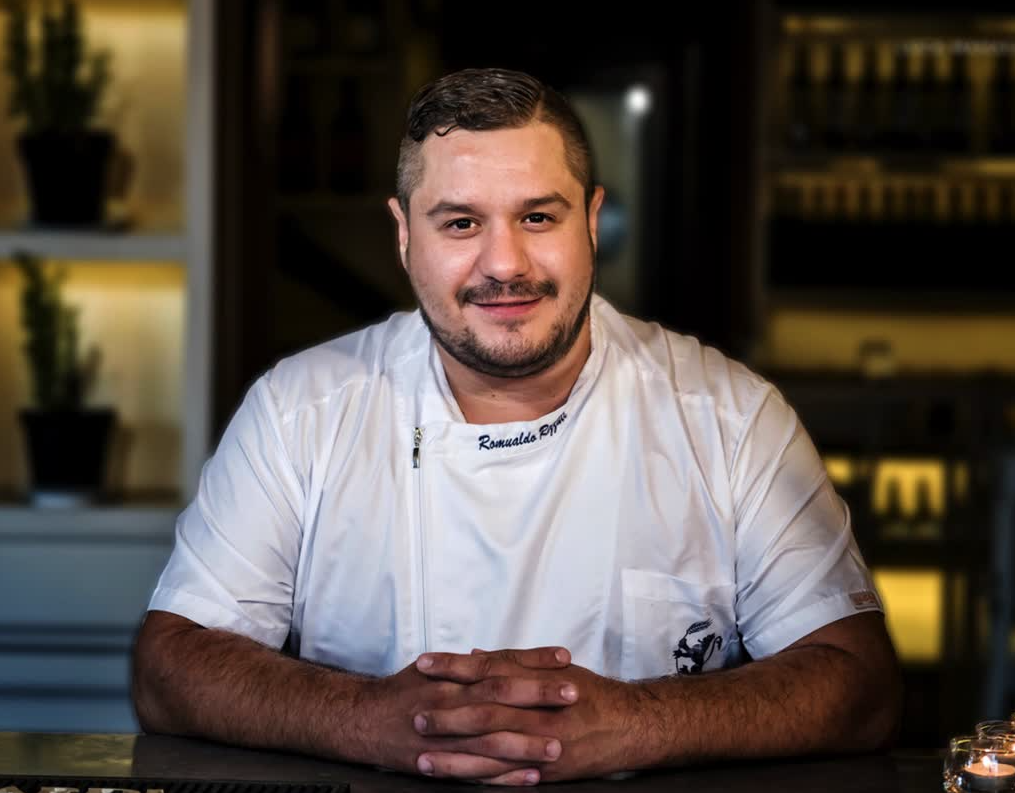
How did you become a pizzaiolo? Was it always your dream?
MM: My passion has always been working with pastry and dough. I began my career as a pastry cook at the Regina Isabella Hotel in Ischia, where I worked for five years, and then I did a year in Rome, at the Grand Hotel Via Veneto. I went back to Ischia and opened my first pizzeria, a family-run business.
RR: When I was 13, my uncle took me with him to a tourist resort, where I started out by helping one of the top pizza chefs in Cilento. From then on, it was my dream to work with food. During my formative years (until I was 23), I was lucky to work alongside many wonderful chefs and that’s where, like some of my colleagues, I absorbed the main techniques and fundamentals of the kitchen, eventually finding my calling with pizza.
GS: I became a pizza chef out of necessity than anything else, even though I liked the world of flour because, as a kid, I loved seeing the pizzaiolo throw the dough down on this pile, which would explode into a cloud. I was 14 when I started working in a pizzeria, which originally just served it by the slice, and later became a takeaway pizza place. I was taught by an old pizzaiolo, Espedito Raffone, who was also a baker. Despite there being a few years between us, his grandson also grew up to be a baker and pizzaiolo; we got to know each other and we became friends. We still call one another up every so often for advice. That’s the way of the pizza world.
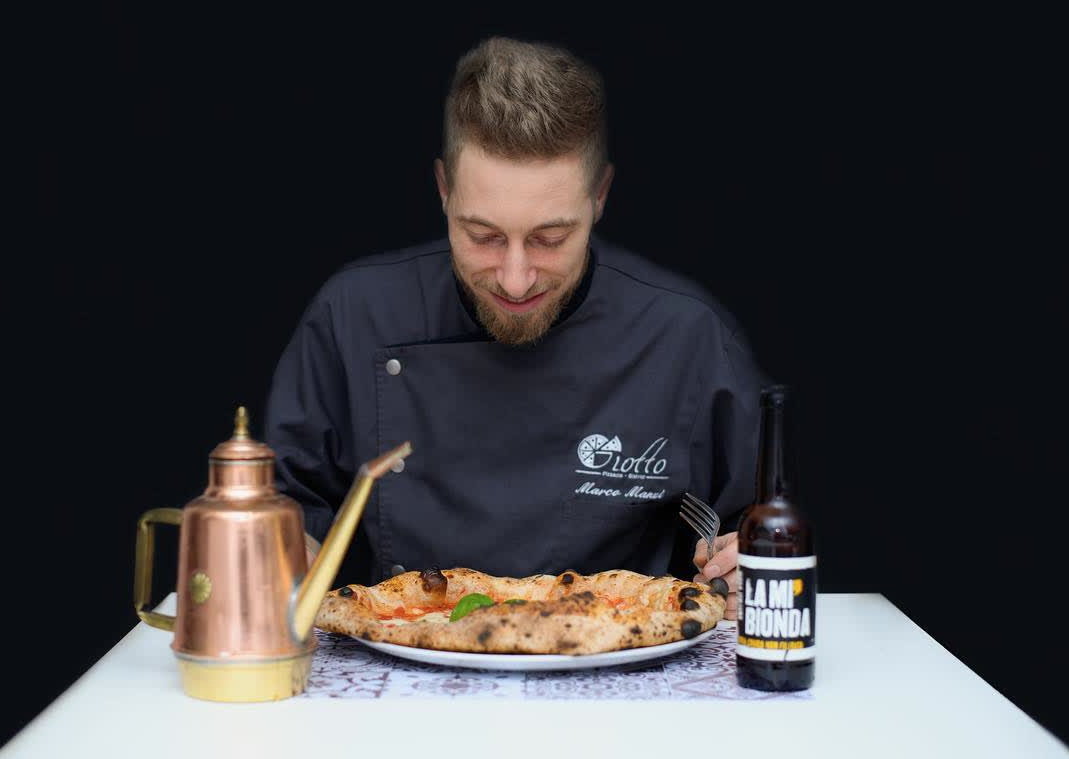
Why Florence?
MM: I followed my love, who wanted to keep studying here at the University of Florence.
RR: Florence is unique. Even after 20 years of living here, I’m still excited whenever I look up and see something new: its monuments, maybe a plaque in memory of someone who lived there. I’m still amazed at how infinitely beautiful it is. People told me not to go to Florence because the Florentines are reserved. It’s true, but once you earn their respect, they treat you as one of their own.
GS: I spent time travelling all over Italy, working in Castellammare, Capri and Calabria. I came to Florence in 1996. For the first two years I did the summer seasons in Vicchio, in the Mugello, returning to Naples and Castellammare in the winter. In 1998 I went back to work on Capri and then I came back up to Florence again, settling here in 1999. Florence and Tuscany have always fascinated me.
Your favourite topping at the moment? And your customers’?
MM: My favourite pizza is Margherita. It’s also the one I sell most. People love simplicity.
RR: We’re talking about pizza. I always say they’re like my children: you can’t pick one. If I had to choose one that best represented me, I’d choose two: pizza fritta (deep-fried pizza) and the Mia Napoli (mine’s as good as anyone).
GS: I love salsiccia e friarielli (sausage and greens). They make for a simple pizza, a Neapolitan favourite, which reminds me of my childhood. Whenever my mum used to make it, I’d stick my hand out just like Totò and spaghetti.
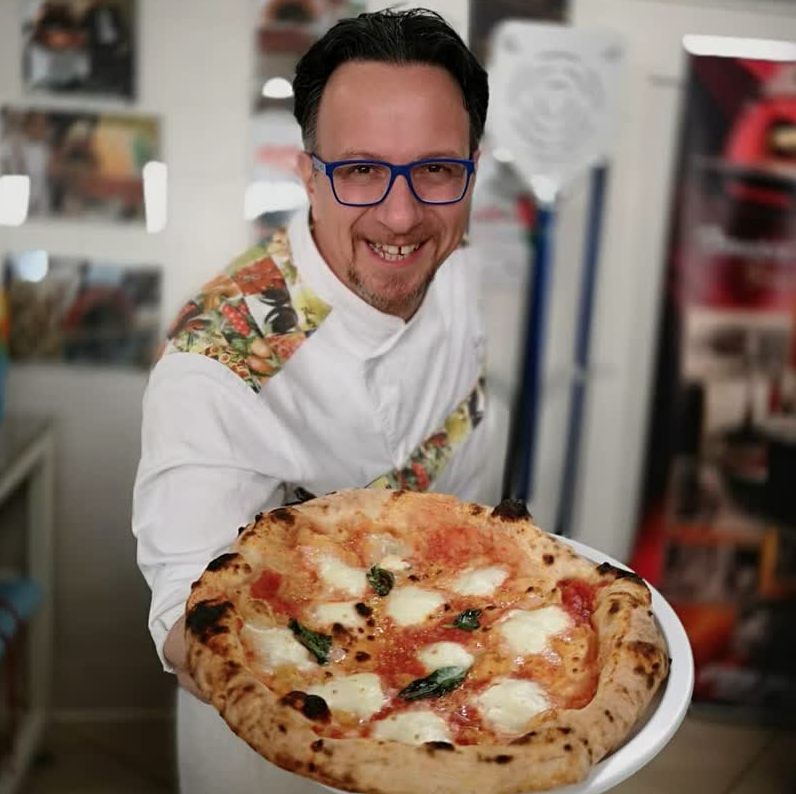
What type of flour do you use?
MM: We use a “0” flour with bits of stone-ground wheat germ.
RR: We’re fortunately to have I Mugnai, the most important mills in the world. For my pizza, being Neapolitan pizza, I use “00” and a “0” flour with wheat germ.
GS: I use Petra from Molino Quaglia. From three different sacks of flour, I’ve developed my own blend, which is what brings the softness and digestibility to my pizzas. I use fairly strong flour given that my dough leavens for a long time.
Rising time?
MM: 36 hours.
RR: I could say so much about this, but I’ll try to keep it simple. The leavening (in my case, 24 or 36 hours) depends on the strength of the flour, which is indicated by the “W” index. Making good pizza also requires good maturation, which is when the dough is kept at a controlled temperature in order to make sure it’s digestible.
GS: I give it around 48 hours. I did the dough this afternoon and it’ll be ready the day after tomorrow. That’s the slow way of doing it.
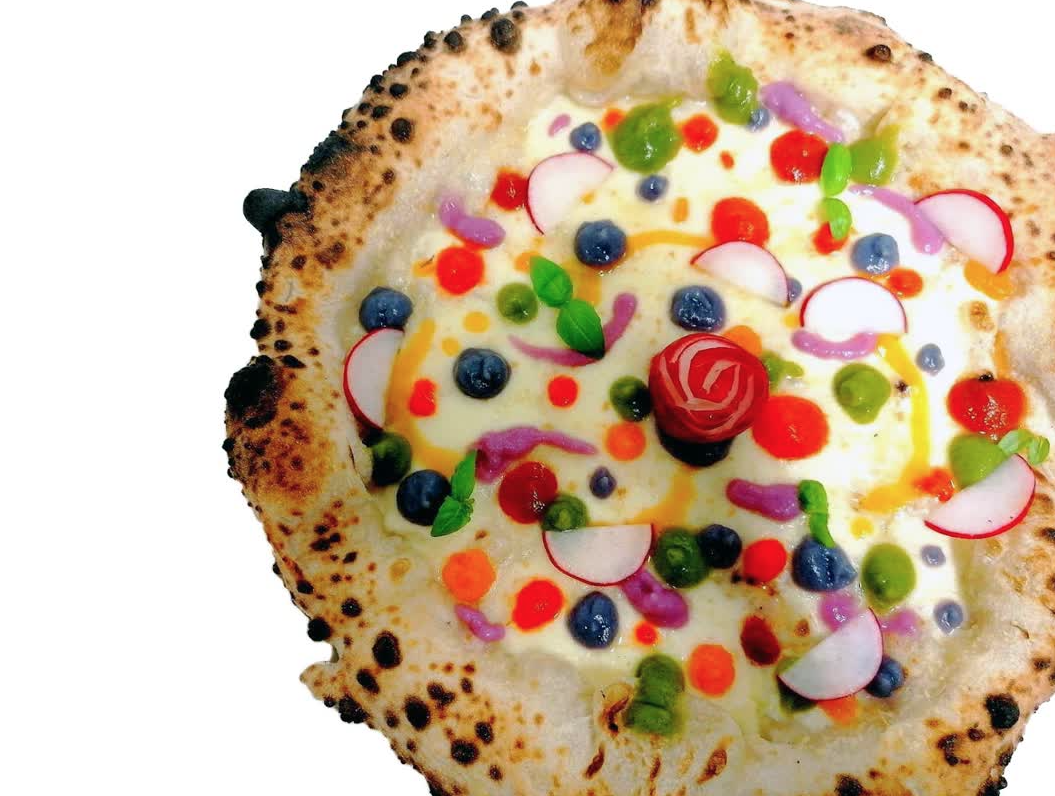
How can customers recognize quality pizza?
MM: Quality ingredients can be recognized in the taste. Look at how the pizzaiolo works and keeps the prep area clean. Last but not least, observe how speckled the cooked dough is and if the crust has filled out properly. It should have pockets of air.
RR: Quality pizza can be recognized by the fact that we digest it properly; in other words, it doesn’t make your stomach feel bloated. After a few hours, you should feel like eating it all over again.
GS: Pizza shouldn’t be burnt on top, just golden. Underneath it should be tigrata, speckled everywhere. When you chew it, it shouldn’t feel like chewing gum. It’s important that the plate isn’t cold because you get a thermal shock, which causes condensation and humidity: the pizza can seem raw, but it’s just wet.
What challenges do you face in serving quality pizza in Florence?
MM: I haven’t found any challenges, even though Florentines prefer pizza that’s thinner and crunchier, rather than soft and moist like typical Neapolitan pizza. The first thing I had to do in Florence was to make my product known to the public, in such a way that they could appreciate it. The fact that customers return has shown me that I’m doing something right. Now, with the restaurant always packed with people who have learned to appreciate this product, which is “outside” their culinary culture, I’m constantly searching for quality ingredients and techniques that will improve my pizza further.
RR: There are still difficulties today. There are still people who think of pizza as a low-cost, mass-market dish. It seems to me that the pizza movement in general has grown a lot in the last seven or eight years. It hasn’t been easy to make people understand that, behind it all, there are ongoing efforts and a lot of work: searching for the best ingredients and investments in all points of view. Fortunately, most people appreciate the work that goes in. Ultimately, I don’t want to think that you fill a pizzeria by having the cheapest deals; I insist on offering the best in terms of quality.
GS: The challenge was in learning how to make pizza according to Tuscan taste (the locals prefer their pizza thinner). I had to cook it slightly more. When I started doing this, while keeping the flavours balanced, Florentines started coming to eat it. Thankfully, they still do.
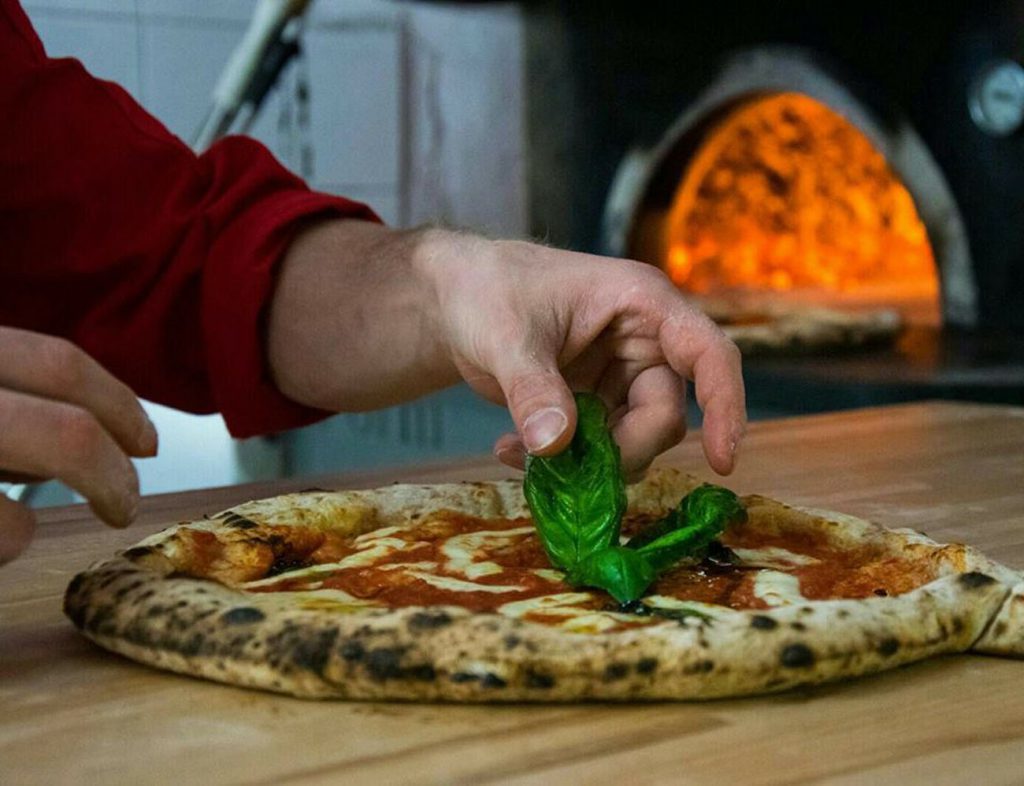
Twice-baked, gourmet, Neapolitan: must we really label every pizza in 2020?
MM: Absolutely, yes, we must. They are completely different styles. In fact, we could say that they are completely different products. Obviously, the “labelling” shouldn’t be used to imply “better or worse”. They are simply different dishes, made with different techniques and processes; all three, as long as they are done with respect for the ingredients, are equally good.
RR: Those were the terms used by Italy’s top restaurant guides, like Gambero Rosso, L’Espresso, 50 Top Pizza, Identità Golose, etc. In my opinion, it’s a good thing, because pizza—I speak as a Neapolitan, obviously—can be done so many ways and with so many names, as long as it’s good, high-quality stuff.
GS: No, the labels don’t matter. What’s important is that we make quality pizza, like quality cooking of any kind, according to the right criteria and right processes and the best ingredients. If you succeed in making people swear aloud, you know you’ve made something exceptional. Or, as we say in Naples, “Mwuah!”
Where do you eat when you aren’t beside the oven in your pizzeria?
MM: All over. Anywhere from the simplest trattoria to Michelin-starred restaurants. And, why not, also at my peers’ pizzerias!
RR: Normally at home or in a Florentine or Tuscan trattoria. When I can eat out though, I sometimes go to a Michelin-starred restaurant or a fellow chef’s restaurant to improve my palate, expand the sensations, and maybe discover some flavour or pairing, as long as I can use it to help propel my cuisine to new heights. In a word, it’s all about passion.
GS: Late morning or lunchtime, I might get a lampredotto from a place near Porta Romana, the same one as in piazza Beccaria: Marco the trippaio. Or I’ll go to the rosticceria next to the restaurant. Maybe a bistecca at Cecchini or Fuoco Matto. I’m also fond of street food. So I mix it up a bit. I might go to Il Vecchio e il Mare, Giotto, or Alberto’s, near Porta San Niccolò, not far from Romualdo’s pizzeria.
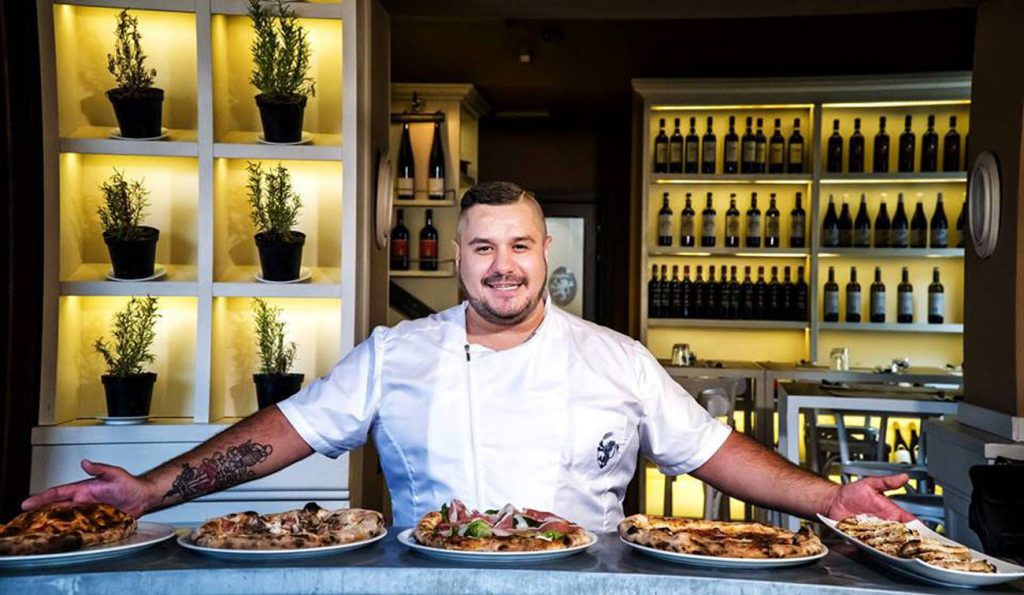
How do you want your customers to remember their experience?
MM: I would like to leave each customer with a piece of me and my background. I put some of my soul into every pizza and some of the happiness I feel at having made most of my dreams come true. It would be nice if everyone could feel all this and smile on a full stomach on going home after a hard day’s work!
RR: I always tell my team that everyone at our table is a pope or a king. Only then can we give them the attention, ingredients, atmosphere and service that they deserve, and help them and their dining companions to spend a good evening that goes beyond just pizza.
GS: I hope they’ll remember the pizza and me. I hope they’ll go home having eaten well.
ONES TO WATCH
The following pizzerias in the city centre also research and source quality ingredients. At Ristorante Accademia (piazza San Marco 7), Matera-born Angelo Natiello sources flour from Antico Mulino Grifon in Casentino for a 24-hour leavened pizza dough, topped with the likes of scamorza cheese, courgette flowers and ventricina, a salami from Abruzzo. Over at Mercato Centrale Firenze, Marco Fierro bakes light and yummy Neapolitan pizzas using sourdough and stone-ground flour: the Margherita is consistently scrumptious. All-organic pizzas are the thing at Simbiosi (via de’ Ginori 56R), with special types of dough putting in an appearance on Wednesday nights.







